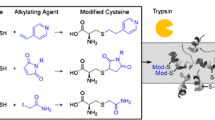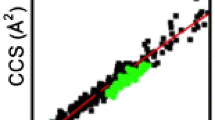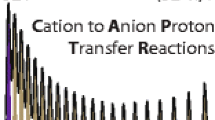Abstract
A new method for probing the equilibrium structures and folding states of proteins utilizing electrospray ionization mass spectrometry is described. Protein structure is explored as a function of side-chain availability as determined by a specific interaction between lysine and 18-crown-6 ether (18C6). Various intramolecular interactions are competitive with the lysine/18C6 interaction and can prevent noncovalent attachment of 18C6. Changes to protein structure modify these inhibiting intramolecular interactions, which leads to a change in the number of 18C6s that attach to the protein. Experiments conducted with cytochrome c, ubiquitin, and melittin reveal that the method is sensitive to changes in both tertiary and secondary structure. In addition, the structure of each charge state can be examined independently. Experiments can be performed under conditions where the pH and amount of organic cosolvent are varied. Control experiments conducted with pentalysine, which lacks structural organization, are also presented.
Similar content being viewed by others
References
Wales, T. E.; Engen, J. R. Hydrogen exchange mass spectrometry for the analysis of protein dynamics. Mass Spectrom. Rev. 2006, 25, 158–170.
Kaltashov, I. A.; Eyles, S. J. Studies of biomolecular conformations and conformational dynamics by mass spectrometry. Mass Spectrom. Rev. 2002, 21, 37–71.
Englander, S. W. Protein folding intermediates and pathways studied by hydrogen exchange. Annu. Rev. Biophys. Biomol. Struct. 2000, 29, 213–238.
Mandell, J. G.; Falick, A. M.; Komives, E. A. Measurement of amide hydrogen exchange by MALDI-TOF mass spectrometry. Anal. Chem. 1998, 70, 3987–3995.
Garcia, R. A.; Pantazatos, D.; Villareal, F. J. Hydrogen/deuterium exchange mass spectrometry for investigating protein-ligand interactions. Assay Drug Dev. Technol. 2004, 2, 81–91.
Zhu, M. M.; Chitta, R.; Gross, M. L. PLIMSTEX. A novel mass spectrometric method for the quantification of protein-ligand interactions in solution. Int. J. Mass Spectrom. 2005, 240, 213–220.
Roulhac, P. L.; Powell, K. D.; Dhungana, S.; Weaver, K. D.; Mietzner, T. A.; Crumbliss, A. L.; Fitzgerald, M. C. SUPREX (stability of unpurified proteins from rates of H/D exchange) analysis of the thermodynamics of synergistic anion binding by ferric-binding protein (FbpA), a bacterial transferrin. Biochemistry. 2004, 43, 15767–15774.
Pan, J.; Wilson, D. J.; Konermann, L. Pulsed hydrogen exchange and electrospray charge-state distribution as complementary probes of protein structure in kinetic experiments: Implications for ubiquitin folding. Biochemistry. 2005, 44, 8627–8633.
Yan, X.; Watson, J.; Ho, P. S.; Deinzer, M. L. Mass spectrometric approaches using electrospray ionization charge states and hydrogen-deuterium exchange for determining protein structures and their conformational changes. Mol. Cell. Proteom. 2003, 3, 10–23.
Grandori, R. Origin of the conformation dependence of protein charge-state distributions in electrospray ionization mass spectrometry. J. Mass Spectrom. 2003, 38, 11–15.
Dobo, A.; Kaltashov, I. A. Detection of multiple protein conformational ensembles in solution via deconvolution of charge-state distributions in ESI MS. Anal. Chem. 2001, 73, 4763–4773.
Fenn, J. B. Ion formation from charged droplets—roles of geometry, energy, and time. J. Am. Soc. Mass Spectrom. 1993, 4, 524–535.
Konermann, L.; Douglas, D. J. Equilibrium unfolding of proteins monitored by electrospray ionization mass spectrometry: distinguishing two-state from multi-state transitions. Rapid Commun. Mass Spectrom. 1998, 12, 435–442.
Konermann, L.; Douglas, D. J. Unfolding of proteins monitored by electrospray ionization mass spectrometry: A comparison of positive and negative ion modes. J. Am. Soc. Mass Spectrom. 1998, 9, 1248–1254.
Julian, R. R.; Beauchamp, J. L. Site specific sequestering and stabilization of charge in peptides by supramolecular adduct formation with 18-crown-6 ether by way of electrospray ionization. Int. J. Mass Spectrom. 2001, 210, 613–623;
Cunniff, J. B.; Vouros, P. Mass and charge state assignment for proteins and peptide mixtures via noncovalent adduction in electrospray mass spectrometry. J. Am. Soc. Mass Spectrom 1995, 6, 1175–1182;
Sproch, N.; Kruger, T. L. Noncovalent interactions of crown ethers with cytochrome c using electrospray mass spectrometry. Proceedings of the 41st ASMS Conference; San Francisco, CA 1993, pp 904a–904b.
Bosch, E.; Bou, P.; Allemann, H.; Rosès, M. Retention of ionizable compounds on HPLC. pH scale in methanol-water and the pK and pH values of buffers. Anal. Chem. 1996, 68, 3651–3657.
Fink, A. L.; Calciano, L. J.; Goto, Y.; Kurotsu, T.; Palleros, D. R. Classification of acid denaturation of proteins: Intermediates and unfolded states. Biochemistry. 1994, 33, 12504–12511.
Mattice, W. L.; Harrison, W. H. Estimation of the Circular Dichroism Exhibited by Statistical Coils of Poly(L-Alanine) and Unionized Poly(L-Lysine) in Water. Biopolymers. 1975, 14, 2025–2033.
Buck, M. Trifluoroethanol and colleagues: Cosolvents come of age. Recent studies with peptides and proteins. Q. Rev. Biophys. 1998, 31, 297–355.
Hirota-Nakaoka, N.; Goto, Y. Alcohol-induced denaturation of â-Lactoglobulin: A close correlation to the alcohol-induced α-helix formation of melittin. Bioorg. Med. Chem. 1999, 7, 67–73.
Bushnell, G. W.; Louie, G. V.; Brayer, G. D. High-resolution three-dimensional structure of horse heart cytochrome c. J. Mol. Biol. 1990, 214, 585.
Konermann, L.; Douglas, D. J. Acid-induced unfolding of cytochrome c at different methanol concentrations: electrospray ionization mass spectrometry specifically monitors changes in tertiary structure. Biochemistry. 1997, 36, 12296–12302.
Suzumura, A.; Paul, D.; Sugimoto, H.; Shinoda, S.; Julian, R. R.; Beauchamp, J. L.; Teraoka, J.; Tsukube, H. Cytochrome c-crown ether complexes as supramolecular catalysts: Cold-active synzymes for asymmetric sulfoxide oxidation in methanol. Inorg. Chem. 2005, 44, 904–910.
Vijay-Kumar, S.; Bugg, C. E.; Cook, W. J. Structure of ubiquitin refined at 1.8 A resolution. J. Mol. Biol. 1987, 194, 531–544.
Brutscher, B.; Bruschweiler, R.; Ernst, R. R. Backbone dynamics and structural characterization of the partially folded A state of ubiquitin by 1H, 13C, and 15N nuclear magnetic resonance spectroscopy. Biochemistry. 1997, 36, 13043–13053.
Ecker, D. J.; Butt, T. R.; Marsh, J.; Sternberg, E.; Shatzman, A.; Dixon, J. S.; Weber, P. L.; Crooke, S. T. Ubiquitin functions studied by disulfide engineering. J. Biol. Chem. 1989, 264, 1887–1893.
Hoerner, J. K.; Xiao, H.; Kaltashov, I. A. Structural and dynamic characteristics of a partially folded state of ubiquitin revealed by hydrogen exchange mass spectrometry. Biochemistry. 2005, 44, 11286–11294.
Dill, K. A.; Shortle, D. Denatured states of proteins. Annu. Rev. Biochem. 1991, 60, 795–825.
Mohimen, A.; Dobo, A.; Hoerner, J. K.; Kaltashov, I. A. A chemometric approach to detection and characterization of multiple protein conformers in solution using electrospray ionization mass spectrometry. Anal. Chem. 2003, 75, 4139–4147.
Wang, F.; Polavarapu, P. L. Conformational analysis of melittin in solution phase: Vibrational circular dichroism study. Biopolymers. 2003, 70, 614–619.
Hirota, N.; Mizuno, K.; Goto, Y. Group additive contributions to the alcohol-induced α-helix formation of melittin: Implication for the mechanism of the alcohol effects on proteins. J. Mol. Biol. 1998, 275, 365–378.
Bazzo, R.; Tappin, M. J.; Pastore, A.; Harvey, T. S.; Carver, J. A.; Campbell, I. D. The structure of melittin: A 1H-NMR study in methanol. Eur. J. Biochem. 1988, 173, 139–146.
Eisenberg, D.; Gribskov, M.; Terwilliger, T. C. PDB ID: 2MLT; unpublished.
Author information
Authors and Affiliations
Corresponding author
Additional information
Published online June 12, 2006
Rights and permissions
About this article
Cite this article
Ly, T., Julian, R.R. Using ESI-MS to probe protein structure by site-specific noncovalent attachment of 18-crown-6. The official journal of The American Society for Mass Spectrometry 17, 1209–1215 (2006). https://doi.org/10.1016/j.jasms.2006.05.007
Received:
Revised:
Accepted:
Published:
Issue Date:
DOI: https://doi.org/10.1016/j.jasms.2006.05.007




